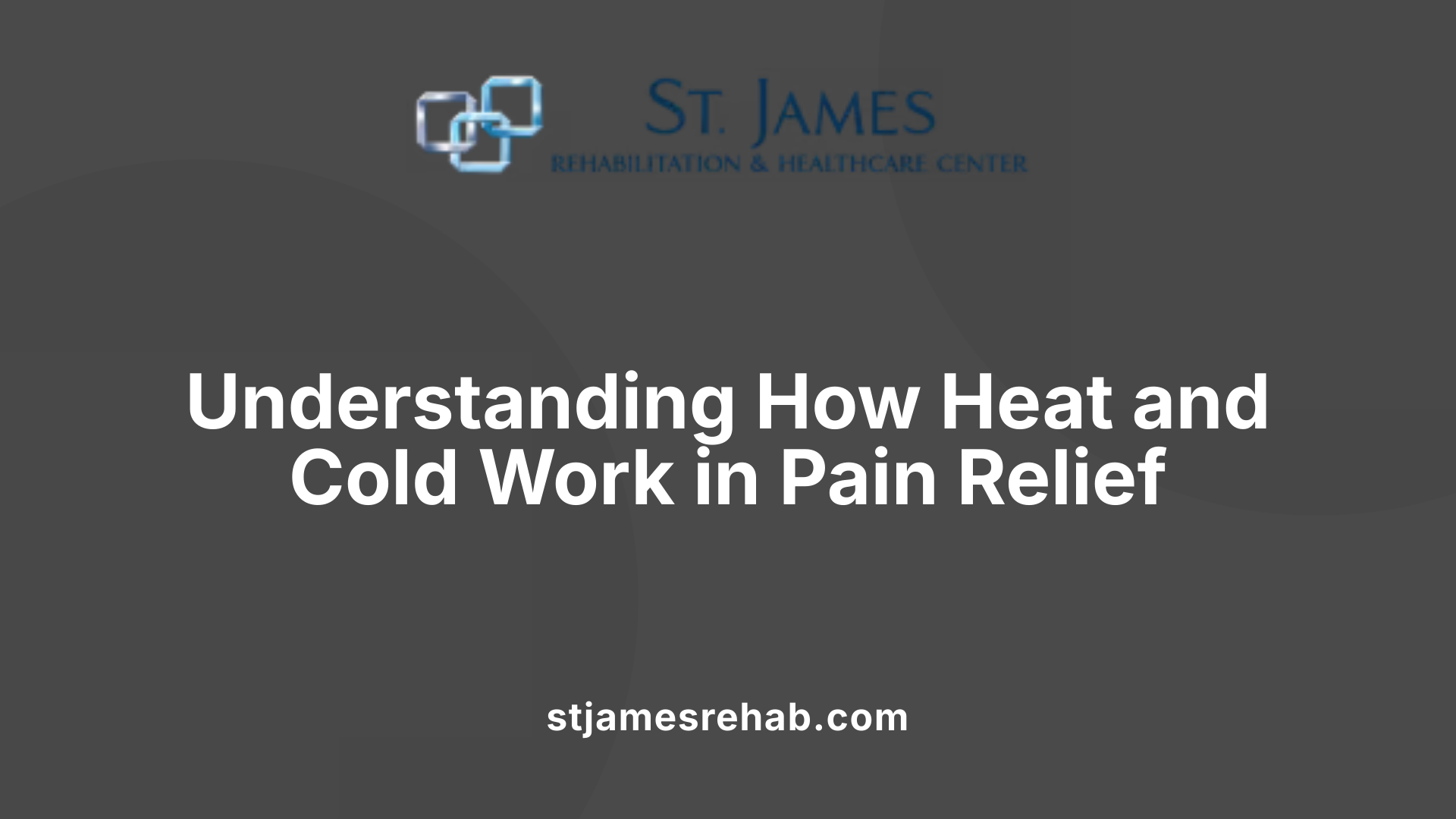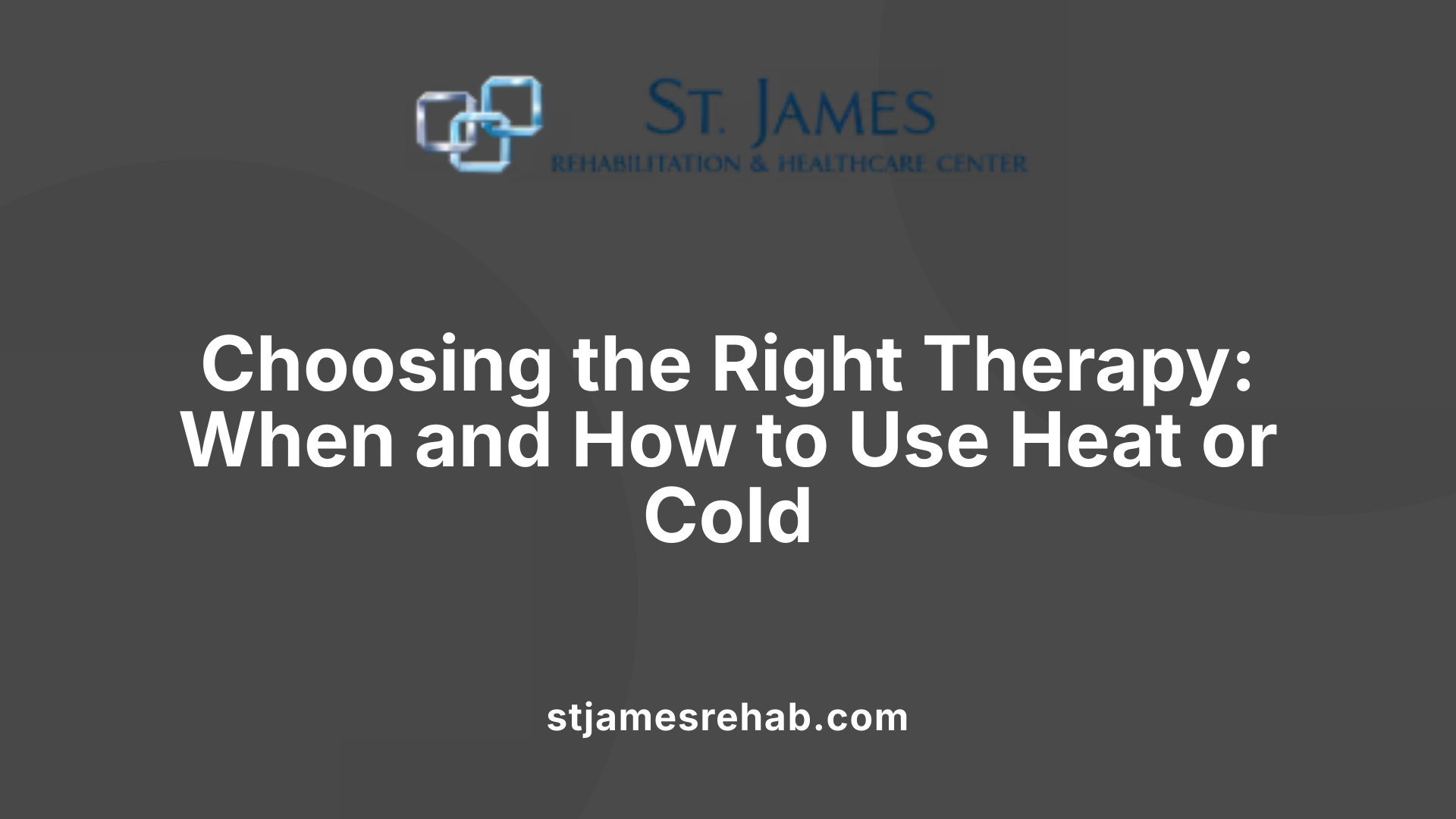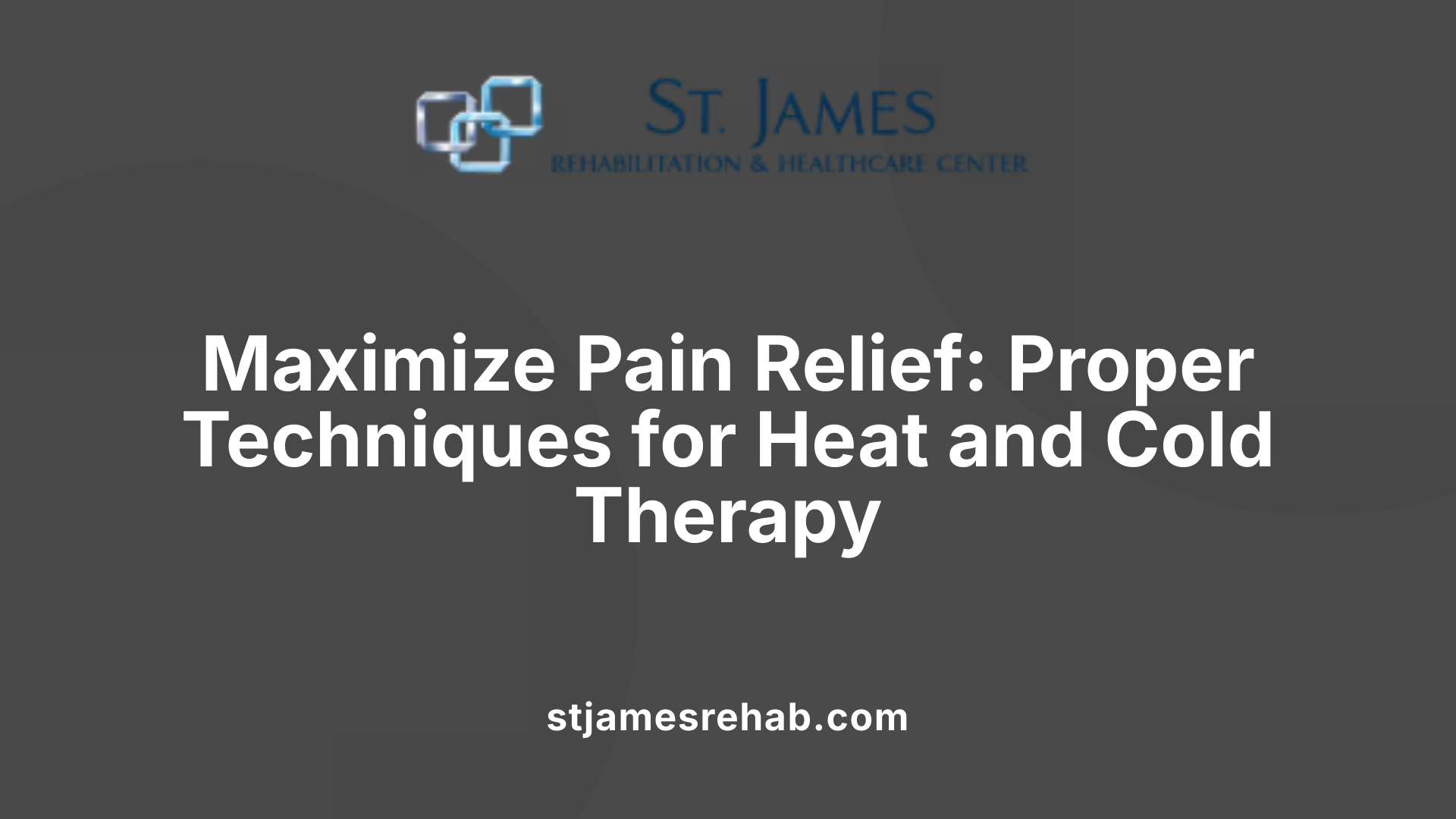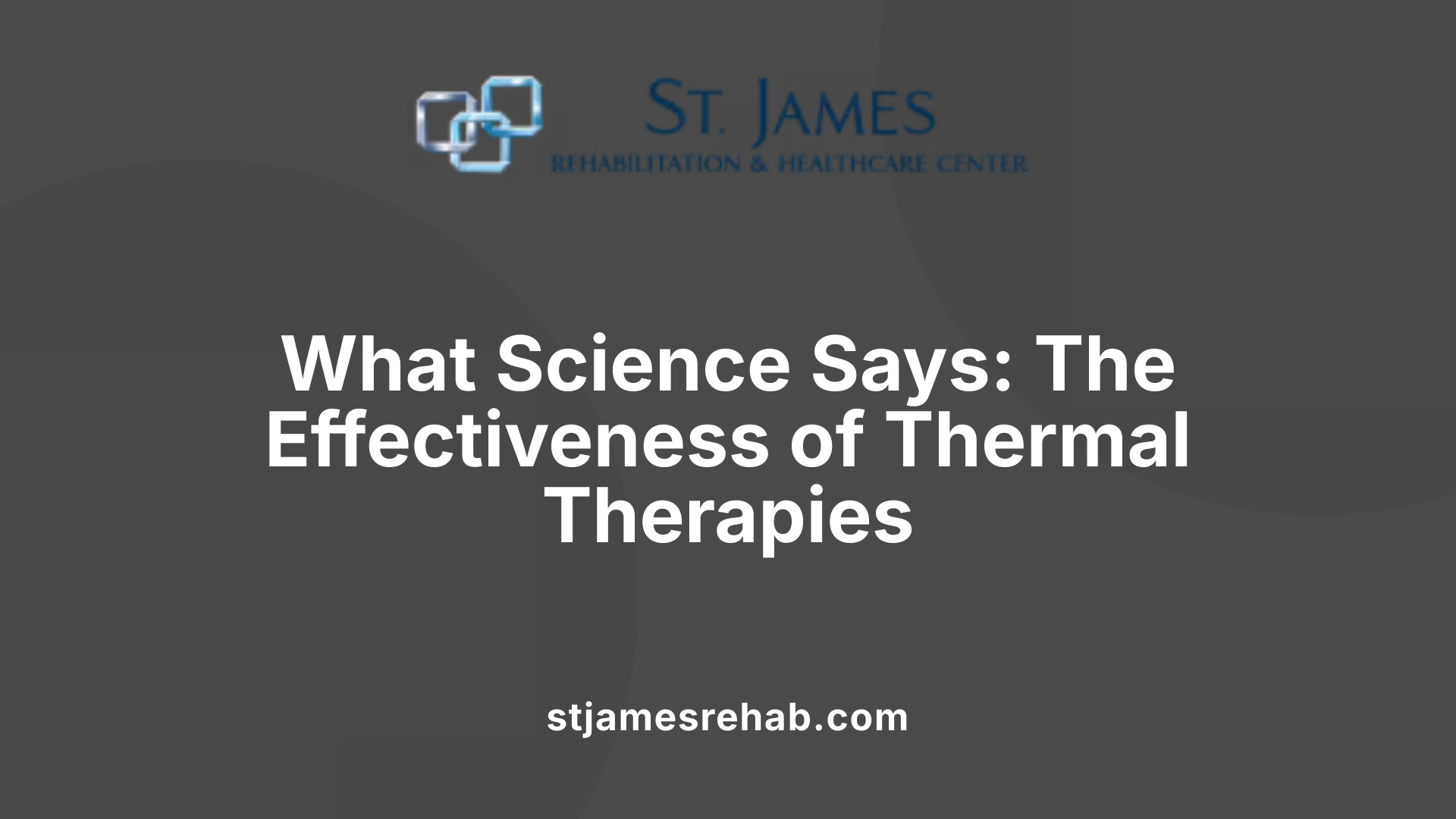The role of heat and cold therapy in managing pain
Harnessing the Power of Thermotherapy and Cryotherapy in Pain Relief

Understanding Heat and Cold Therapy in Pain Management
Heat and cold therapies are longstanding, evidence-based approaches to alleviating pain and managing inflammation. Their physiological effects on blood flow, nerve activity, and tissue health make them versatile tools in both acute injury management and chronic pain conditions. This comprehensive overview explores the mechanisms, applications, safety precautions, and scientific support for these therapies, emphasizing their vital role in modern pain management strategies.
Mechanisms of Heat and Cold Therapy in Pain Management

How does heat and cold therapy work in pain management?
Heat therapy works by increasing blood flow to the affected area, which helps deliver essential nutrients and oxygen, promoting healing. It also relaxes tense muscles and eases joint stiffness, making it effective for chronic pain conditions such as arthritis or muscle tightness.
Cold therapy, on the other hand, reduces inflammation and swelling by constricting blood vessels, decreasing tissue metabolism, and numbing nerve activity. This leads to quick pain relief, especially immediately after an injury or during inflammatory flare-ups.
Using these therapies in an alternating pattern can help modulate blood flow, reduce inflammation, and control pain across different stages of healing. Applying heat before activity or during chronic pain; using cold in acute injury phases; and alternating them for recovery are common strategies.
How heat therapy increases blood flow and relaxes muscles
Heat therapy causes vasodilation, which enlarges blood vessels, increasing blood flow to the area. This process helps deliver nutrients, remove metabolic waste products, and reduce muscle spasms or stiffness. It also increases tissue elasticity, facilitating movement and decreasing discomfort.
How cold therapy reduces inflammation and numbs pain
Cold therapy causes vasoconstriction—narrowing blood vessels—which reduces blood flow, swelling, and inflammation. It also decreases nerve conduction velocity, providing a numbing effect that diminishes pain sensations. This makes cold therapy particularly useful immediately after injury to control initial swelling and pain.
The biological effects of vasodilation and vasoconstriction
Vasodilation, triggered by heat, enhances blood flow, aiding tissue repair and decreasing muscle stiffness. However, excessive vasodilation immediately after injury can increase swelling. Vasoconstriction, induced by cold, reduces blood flow, inflammation, and oxygen demand, helping to minimize tissue damage and inflammation. Both responses are vital in different phases of injury and recovery, and understanding their mechanisms helps clinicians tailor pain management strategies.
Types and Methods of Application for Thermotherapy and Cryotherapy
What are the different types and methods of applying heat and cold therapy?
Heat therapy is commonly applied through dry and moist methods. Dry heat methods include the use of heating pads, infrared lamps, and hot packs, which deliver warmth through direct contact or radiation. Moist heat, on the other hand, involves warmer, water-based sources such as warm baths, steam towels, and hydrotherapy, often providing more effective heat transfer and comfort.
Cold therapy, also known as cryotherapy, employs several options depending on the injury and patient preference. Ice packs and gel packs are widely used, often wrapped in a towel to prevent skin damage. Coolant sprays provide quick application and are useful for localized pain. Ice massage and ice baths are other methods that help reduce swelling and numb the area, offering immediate relief.
Choosing the appropriate method depends on the specific pain condition, injury type, and desired temperature. Treatments are generally applied for 10-20 minutes at a time, with protective barriers in place to avoid skin burns or frostbite.
This versatility allows healthcare providers and individuals to adapt applications based on their needs, ensuring safe and effective pain management that fosters tissue healing and alleviates discomfort.
Appropriate Conditions and When to Use Heat or Cold Therapy

In what conditions and scenarios is heat or cold therapy appropriate?
Heat therapy is generally beneficial for chronic conditions involving muscle stiffness, joint pain, and persistent discomfort. It works by increasing blood flow, relaxing muscles, and improving tissue flexibility, which is particularly helpful for ailments like arthritis or after the muscles have warmed up from exercise. Use heat therapy when inflammation is not active or swelling has minimized, as it can promote healing and relieve ongoing pain.
On the other hand, cold therapy is most effective immediately following an acute injury such as a sprain, strain, or recent bruise. It helps by constricting blood vessels, reducing swelling and inflammation, and numbing the area to decrease pain. Cold treatment is typically applied within the first 48 hours post-injury to control inflammation and prevent further tissue damage.
During recovery, alternating between heat and cold treatments, known as contrast therapy, can be advantageous. Cold treatments reduce initial inflammation and swelling, while subsequent use of heat can enhance circulation, loosen tissues, and facilitate healing. This strategic approach optimizes pain management and tissue repair.
Common applications of heat and cold therapies include:
| Condition or Scenario | Recommended Therapy | Why? |
|---|---|---|
| Chronic muscle stiffness or joint pain | Heat therapy | Promotes blood flow, relaxes muscles, and improves flexibility |
| Recent sprain, strain, or bruise | Cold therapy | Reduces swelling, diminishes inflammation, and numb pain |
| Post-exercise muscle soreness | Alternating heat and cold | Aids in recovery by reducing soreness and improving circulation |
| Arthritis flare-ups | Heat therapy | Eases stiffness and improves joint mobility |
| Acute injuries within 48 hours | Cold therapy | Minimizes swelling and prevents excess tissue damage |
Using the appropriate therapy at the right time can significantly enhance healing, reduce discomfort, and improve overall recovery outcomes. Always consult healthcare professionals for personalized treatment plans and be cautious of contraindications such as open wounds, skin sensitivity, or underlying health conditions.
Best Practices for Using Heat and Cold Therapies Effectively

How should heat and cold therapies be applied for maximum benefit?
To maximize the effectiveness of heat and cold treatments, it is essential to follow proper application techniques. Both therapies should generally be applied for about 10 to 20 minutes per session. This duration helps prevent potential tissue damage while providing sufficient relief.
When applying heat, use barriers such as towels or cloths between the heat source (like a heating pad or hot water bottle) and the skin. This prevents burns that can occur from excessive heat. Similarly, cold therapy products such as ice packs or gel packs should also be wrapped in a cloth to avoid frostbite or skin irritation.
These treatments are most effective when repeated several times throughout the day, often two to three sessions, depending on the specific condition and individual tolerances. It is advisable to monitor the skin for signs of redness, numbness, or discomfort and to discontinue if adverse reactions occur.
Alternating between heat and cold therapies can further promote healing—cold reduces inflammation and numb pain, while heat increases blood flow and relaxes muscles. However, each switch should adhere to the recommended time limits and protective measures.
Consistent and careful application following these practices can enhance relief, aid recovery, and minimize risks associated with misuse.
Safety Precautions and Contraindications in Heat and Cold Therapy

What precautions should be taken to use heat and cold therapies safely and effectively?
To ensure safety during heat and cold treatments, it is crucial to use protective barriers like towels or cloths when applying packs or devices directly on the skin. Limiting the duration of each session to 10-20 minutes helps prevent skin burns from excessive heat or frostbite from cold exposure.
It is important to avoid applying these therapies over broken skin, open wounds, or areas with poor blood flow, as it can worsen damage or hinder healing. People with sensory issues, such as numbness or impaired sensation, should be especially cautious because they may not detect adverse effects like burns or frostbite.
Individuals with certain health conditions such as diabetes, dermatitis, vascular diseases, deep vein thrombosis (DVT), or multiple sclerosis (MS) should consult healthcare providers prior to using heat or cold therapies. These conditions can increase the risk of complications or reduce the effectiveness of the treatments.
Proper application and awareness of personal health status are essential in safely incorporating thermotherapy and cryotherapy into pain management routines.
The Role of Heat and Cold Therapy in Injury Recovery and Prevention
What is the role of heat and cold therapy in injury recovery and prevention?
Cold therapy, such as ice packs, is most effective immediately after an injury occurs. Its primary function is to reduce swelling, inflammation, and pain by constricting blood vessels and numbing nerve activity at the affected site. This helps minimize tissue damage during the early, acute phase of injury.
Heat therapy, on the other hand, is generally used later in the recovery process. Applying warm packs, hot baths, or moist heat increases blood flow to the region, which promotes tissue repair, relaxes tight muscles, and alleviates stiffness. By accelerating circulation, heat therapy supports the removal of inflammatory byproducts and encourages healing.
When combined appropriately, these therapies can significantly enhance recovery. Cold treatment immediately after injury reduces initial inflammation and pain, while heat application later helps in relieving muscle tension and improving flexibility. Proper timing and application are crucial to avoid aggravating the injury, as heat should not be used within the first 48 hours of injury when swelling is active.
Cold therapy to minimize initial tissue damage after injury.
Cold therapy methods like ice packs, coolant sprays, and ice baths are used within the first 48 hours following an injury. They effectively reduce blood flow, swelling, and nerve activity, which limits tissue damage and decreases pain.
Applying cold therapy for 10 to 20 minutes several times a day helps control inflammation and prevents hematoma formation. It is especially beneficial for injuries such as sprains, strains, or acute inflammation. However, prolonged cold application can cause tissue damage, so protective barriers like towels should be used.
Heat therapy to facilitate blood flow and tissue healing later in recovery.
Heat therapy methods include dry heat (heating pads, infrared lamps) and moist heat (warm baths, steamed towels). They are used after the initial swelling has subsided—usually beyond 48 hours post-injury—to enhance circulation, relax muscles, and facilitate healing.
Applying heat helps deliver nutrients and oxygen to tissues, promotes elasticity of connective tissues, and reduces muscle spasms, which collectively support recovery. Caution must be taken to avoid heat application on open wounds or swollen areas, as it could worsen inflammation.
The importance of timing and combining therapies.
The effectiveness of heat and cold therapies depends on their correct timing and use in complement. Cold therapy should be used during the first 48-72 hours after injury to minimize swelling and pain. After this period, switching to heat therapy can aid in muscle relaxation and tissue repair.
Some treatment protocols recommend alternating cold and heat to manage both inflammation and stiffness. This contrast therapy can produce vasoconstriction followed by vasodilation, improving circulation and reducing soreness.
Always consult healthcare professionals to tailor the appropriate timing and technique for individual cases. Proper application duration—usually 10 to 20 minutes each session—is important to prevent skin damage.
In conclusion, understanding when and how to apply heat and cold therapy allows for more effective injury management and prevention of further damage, speeding up recovery and restoring function.
Scientific Evidence Supporting Heat and Cold Therapy in Pain Management
 Research studies indicate that both heat and cold therapies are effective in managing various types of pain. For example, heat therapy has been shown to help with arthritis, musculoskeletal injuries, and delayed onset muscle soreness (DOMS). It works by increasing tissue temperature and blood flow, which promotes healing, relaxes muscles, and reduces stiffness.
Research studies indicate that both heat and cold therapies are effective in managing various types of pain. For example, heat therapy has been shown to help with arthritis, musculoskeletal injuries, and delayed onset muscle soreness (DOMS). It works by increasing tissue temperature and blood flow, which promotes healing, relaxes muscles, and reduces stiffness.
Conversely, cold therapy is primarily effective for acute injuries. It reduces inflammation, swelling, and nerve activity, providing quick pain relief. Methods such as ice packs and ice baths are commonly used in the initial phase following injury to minimize tissue damage and control pain.
However, despite these promising findings, current high-quality evidence remains limited. Most existing studies demonstrate short-term benefits, but more rigorous research is needed to confirm their long-term efficacy and applicability across different patient populations.
| Study Focus | Evidence of Effectiveness | Application Context | Additional Notes |
|---|---|---|---|
| Arthritis | Heat therapy reduces stiffness and pain | Chronic condition managed with thermotherapy | More large-scale RCTs needed |
| Musculoskeletal Injuries | Cold therapy decreases swelling and pain | Acute post-injury period | Need for standardized protocols |
| DOMS (Delayed Onset Muscle Soreness) | Heat therapy alleviates soreness | Post-exercise recovery | Mixed results; contrast therapy sometimes used |
Overall, scientific investigations support the use of thermal therapies, but further high-quality research is essential to define their optimal use in pain management.
Summary and Final Recommendations
Heat and cold therapies serve distinct but complementary functions in managing pain and injury. Heat therapy, including methods like hot packs and warm baths, enhances blood flow, relaxes muscles, and increases tissue flexibility. This makes it particularly effective for chronic conditions such as arthritis, muscle stiffness, or post-exercise soreness. Cold therapy, on the other hand, constricts blood vessels, reduces inflammation, swelling, and numbs pain, making it optimal for acute injuries like sprains, strains, or inflammation.
Choosing the right treatment depends on the specific condition and timing. Cold therapy is generally recommended within the first 48 hours after an injury to minimize swelling and pain. As swelling subsides, heat therapy can promote healing, reduce stiffness, and increase comfort. Alternating both therapies, known as contrast water therapy, can help reduce muscle soreness following exercise.
It’s crucial to tailor these treatments to individual needs, considering factors like skin sensitivity, circulation, and underlying health conditions. Proper application—limiting sessions to 10-20 minutes, using barriers to prevent burns or frostbite, and avoiding use on open wounds or areas with poor circulation—is essential for safe and effective relief.
Consulting healthcare professionals is advised for persistent pain, worsening symptoms, or when uncertain about which therapy to use. They can recommend appropriate treatment plans and address any safety concerns, especially for individuals with pre-existing conditions like diabetes, nerve damage, or poor circulation.
For those exploring further, searching for "thermotherapy and cryotherapy for musculoskeletal conditions" can provide detailed insights into the latest studies and applications. Overall, understanding the appropriate use of heat and cold therapies can significantly enhance injury recovery and pain management efforts.
Optimizing Pain Relief with Heat and Cold Therapies
Appropriate application of heat and cold therapies, guided by individual needs and safety precautions, can significantly enhance pain relief and support tissue healing. Their proper combined use, under professional guidance when necessary, offers a powerful means to manage various pain conditions effectively, improve mobility, and prevent injuries.
References
- Treating Pain with Heat and Cold - Healthline
- EFFECT OF COLD AND HEAT THERAPIES ON PAIN RELIEF IN ...
- Ice Packs vs. Warm Compresses For Pain | Johns Hopkins Medicine
- Mechanisms and efficacy of heat and cold therapies for ... - PubMed
- Using Cold and Heat Therapies - MyHealth Alberta
- Importance of heat therapy in the treatment of pain in the daily ...
- Cryotherapy Cold Therapy for Pain Management
- Heat vs Cold: What works better? | UNC Health Appalachian | NC
- Heat and cold treatment: Which is best? - Medical News Today






